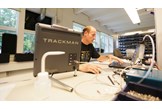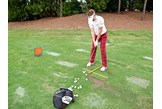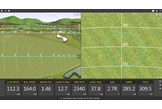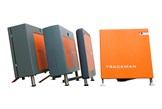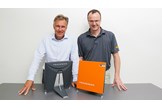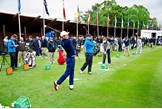Behind the scenes at TrackMan, the company revolutionising golf
Published:
-
TrackMan launch monitors widely used by golf professionals
-
Able to measure exactly what the ball and club are doing at impact
-
Tiger Woods, Rory McIlroy, Ian Poulter and Justin Rose all own one
-
PGA Tour uses TrackMan for its official statistics
In 2002, three golf-mad Danes had an idea. One of them was Klaus Eldrup-Jørgensen, a talented golfer who had represented the Danish national team and competed in several European Tour events before taking his parents’ advice and focusing on the world of business. The other two were Klaus’ brother Morten and his business partner Carsten Hallas, who ran four large driving ranges across Europe, spending large chunks of their time watching keen amateurs hit golf balls in the pursuit of improvement. Together, they realised that something was missing. Golfers would hit balls, watch the flight, and guess what caused the ball to do what it did. The trio found this guesswork unacceptable. They felt that golfers should have something that told them exactly what the ball was doing – and why.
Their research led them to one of the world’s leading military radar companies, based in their homeland of Denmark, using Doppler technology to track missiles and projectiles. A pitch to use the technology in golf fell on deaf ears, apart from one man. Radar scientist Fredrik Tuxen, himself a keen golfer with a handicap of five, saw something in the idea that his colleagues did not. A few weeks later, Fredrik had quit his job and joined Klaus in his garage, working on designs for a radar that could track golf balls in a way that had never been done before. TrackMan had been born.
“There is no big difference between tracking a military projectile and a golf ball,” says Fredrik, now TrackMan’s Chief Technological Officer. “I had actually once hit a golf ball in front of one of the military radars, just for fun, so I could see that the technology had some value. The problem was that those military radars cost £2,000,000 each. Our challenge was to produce something that could track golf balls with the same accuracy, but with a more affordable price tag.”
“People say that TrackMan now is expensive,” laughs Chief Executive Officer Klaus, “but it is not two million pounds!”
With a small team of engineers on board, it was two years before TrackMan had a device that could accurately measure ball flight.
“We weren’t willing to compromise,” recalls Fredrik. “We have always wanted to be the most accurate. You should not be able to see with your eye that the ball landed somewhere other than what the device is telling you. There had been so many devices that said, ‘your distance is this and bla bla bla,’ but they didn’t know a thing. They give you a number, but it is a guess.”
With their product ready, the next step was to find some customers. Fredrik and Klaus journeyed to America on a coast-to-coast trip, stopping off at five States and five leading manufacturers in five days. “We met Nike, Ping, TaylorMade, Callaway and Mizuno,” says Klaus. “It was difficult to get the meetings, because there had been so many people throughout the years calling these companies and telling them what they could do in terms of tracking the golf ball, but they couldn’t do it. They had all oversold what they could do.”
Pitching a device that at the time came with a six-figure price tag to companies who had heard it all before was never going to be easy, but Klaus and Fredrik had something on their side: an orange box that spoke for itself.
“We visited Nike in Texas and there were seven of their employees sat around a table, expecting us to present to them,” says Fredrik. “We told them that we have a presentation, but we’d rather go to the range and show you the product. We went to the range at the back of their building, I set it up, hit one shot, they saw the live tracking and the numbers, and without asking a single question, they all started clapping.”
“We presented to Nike, and without asking a single question, they all started clapping”
“They said to us, ‘You are going to get rich, guys!’” laughs Klaus. “At Callaway, one guy said he’d give us 15 minutes late in the afternoon. We took him out to show him the product, and after one shot he said, ‘Wait here a minute’. Within minutes we were surrounded by about 20 people from Callaway, including some very important people. Richard Helmstetter had come out; he’s the guy who made the first Big Bertha.”
After five meetings, Klaus and Fredrik had their first five sales. Each manufacturer had previously had a team working on developing their own tracking technology to aid them in the design of balls and clubs, but after Klaus and Fredrik turned up on their doorstep, they dropped these projects, knowing they couldn’t match what TrackMan offered.
“Ping had a robot hitting balls all day,” says Fredrik, “but then they had a spotter running around on the range, saying ‘This is where it landed,’ and then they would shoot him with a laser to get the distance.
“When we demonstrated to them, we said ‘217 yards, five to the right,’ while the guy was still running around. When he got there, they lasered him, and we were spot-on.
“One of the companies had installed hundreds of microphones underneath their driving range, so the sound would tell them where it bounced. It was incredibly expensive, but very inaccurate.”
“I don’t know how many manufacturers there were back then – maybe 40 or 50 – and every one of them bought TrackMan,” says Klaus.
“Some of these companies said to me that they were scared of what this technology would do to their company, because now they can’t hide behind marketing and unproven claims,” adds Fredrik. “For the first time, there was proof of whether something works or doesn’t work. It forced them to raise their game. On a demo day, if you are thinking about buying a new driver, you want to know that it is actually performing better than what you have. You hit your existing driver five times, hit the new one five times, and you can compare your distance and dispersion. The manufacturers realised that if they could not offer something better than what was already in use, they would not be able to sell it.”

TrackMan’s unrivalled accuracy quickly caught the attention of the PGA Tour, who have been using it to track statistics at events since 2006.
The next breakthrough came in 2007, when Fredrik realised that the radar was able to track what the clubhead was doing, as well as the ball. “Today, that’s probably the most important part of what we do,” says Klaus. “The club and the ball only impacts for 1/2,000th of a second, but we can see exactly what the club is doing. Is the club coming from in-to-out or out-to-in? Are you hitting down on the ball, or up on the ball? Is the clubface open, closed, or square? You cannot see that on a video.
“The manufacturers were scared, because they could no longer hide behind unproven marketing claims”
“We tried it countless times, showing pros videos of someone swinging and asking them to say what the club is doing at impact. I promise you, you can’t see it. You need the data. We can see it to within a fraction of a degree.”
This breakthrough took TrackMan from a club design and fitting tool to a must-have in instruction. “We believe that you cannot teach without knowing this data,” says Klaus. “If you do not know whether your student is swinging two degrees in or two degrees out, you cannot help them. People thought that you could just look at the flight of the golf ball and work out what was wrong, but you can’t.
“We now know that there are many combinations of things that can give the same ball flight. If you decide on the wrong combination and start trying to fix it, you could be teaching the direct opposite of what you should be doing. You need to know what the club is doing, not just guess. A few years from now, students will not accept it if a coach does not have the number. If you cannot prove the effectiveness of what you are doing – if you cannot improve the numbers, then you are not doing a good job.”
The world’s best golfers were quick to realise just how useful this technology could be. “Over 350 pros have a TrackMan, across the ladies and men’s tours,” says Klaus. “I cannot think of any top player who does not have one. We do not give them away. They have to buy them. Tiger Woods, Rory McIlroy, Justin Rose, Ian Poulter – they have all bought them. Our philosophy was that if you give things away for free, people will just say, ‘Yes, I’ll have one,’ but you will never know if they really want it. If they pay £15,000 for it, it’s because they need it. That’s the best endorsement you can get.”

One of TrackMan’s most far-reaching impacts to date has been its ability to measure and disprove false wisdom that had been relied upon for decades.
“There were so many misconceptions in golf,” says Fredrik. “We have been myth-busting since day one. When I was taught to play golf, I was told that the direction of your swing is what dictates the initial direction of the ball. That’s almost the exact opposite of the truth! The face is much more what dictates where the ball starts. If you think the ball is going right because that is the direction you are swinging, your instinct will be to swing more to the left. You won’t have fixed the face angle, which was the actual reason you were hitting it to the right, so now you are hitting a push-slice, which will go even further right! All because you didn’t know what was causing your shot.”
“We educated the market,” adds Klaus. “We created the ball flight laws, because they were wrong. What had been taught for 30 to 40 years was wrong. The information we created is now being used in the education materials by the PGA in every country. They use our material to educate new pros, because they know it is correct.”
“Golf is a difficult enough game as it is, without relying on false knowledge,” says Fredrik. “We can help with that.”
“Golf is difficult enough as it is, without relying on false knowledge”
TrackMan’s impact has been huge. Over half a million shots a day are hit in front of a TrackMan unit, every single one of them stored on a data cloud. You will not find a club or ball that has been developed without it. You will not find a Tour pro who does not use it. As time goes by, you will find fewer and fewer coaches who will attempt to improve your swing without it. TrackMan has grown into a global company with 130 employees, over half of whom are based in the Copenhagen head office, where every unit is still built by hand.
But Klaus and Fredrik are not finished yet. “We have a new TrackMan coming out this October,” says Klaus. “For the first time, it will have two radars. This enables us to increase the accuracy and the pick-up rate even further. When you only have one radar, it has to focus on the club two metres in front, and a golf ball that is 300 yards away. With two radars in TrackMan 4, one can focus on the club, while the other focuses on the ball. The quality of the data will be second to none.”

“Throughout the 12 years that we have been in business, if we are not 100 per cent sure that a number is an exact number, we don’t show you a number. We’d rather show you an empty box than guess at a number. Some launch monitors will give you a number on every shot, because they would rather guess than admit to not being able to give a number. If you give a bad number, someone may teach the wrong thing. We don’t want that. The frequency of no number will go down dramatically with the new TrackMan.”
“Ultimately,” reflects Klaus, “our goal is to help golfers understand what is happening so they can play better golf.”

